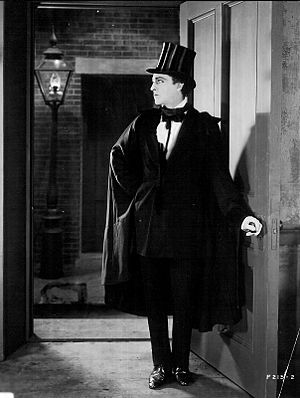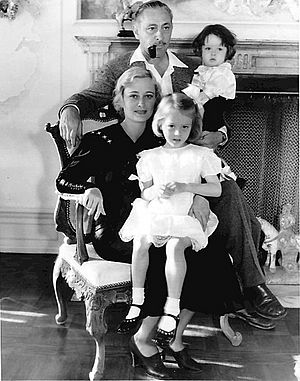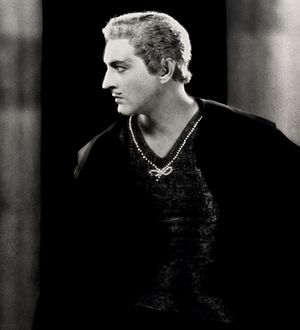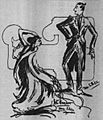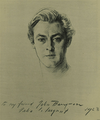John Barrymore facts for kids
Quick facts for kids
John Barrymore
|
|
|---|---|
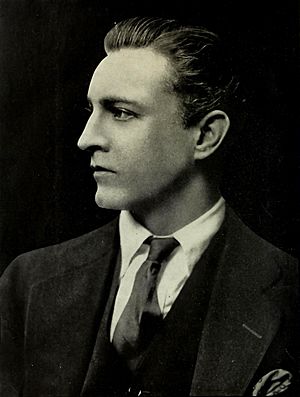
Barrymore in 1920
|
|
| Born |
John Sidney Blyth
February 14 or 15, 1882 |
| Died | May 29, 1942 (aged 60) Los Angeles, California, U.S.
|
John Barrymore (born John Sidney Blyth; February 14 or 15, 1882 – May 29, 1942) was an American actor on stage, screen and radio. A member of the Drew and Barrymore theatrical families, he initially tried to avoid the stage, and briefly attempted a career as an artist, but appeared on stage together with his father Maurice in 1900, and then his sister Ethel the following year.
Early life: 1882–1903
Barrymore was born John Sidney Blyth in the Philadelphia home of his maternal grandmother Louisa Lane Drew and was known by family, friends and colleagues as "Jack". Although the Barrymore family Bible puts his date of birth as February 15, 1882, his birth certificate shows February 14. He was the youngest of three children. His siblings were Lionel (1878–1954), and Ethel (1879–1959). His father was Maurice Barrymore, an Indian-born British actor who had been born Herbert Blyth, and had adopted Barrymore as a stage name after seeing it on a poster in the Haymarket Theatre in London. Barrymore's mother, Georgie Drew Barrymore, was born into a prominent theatrical family. His maternal grandparents were Louisa Lane Drew, a well-known 19th-century American actress and the manager of the Arch Street Theatre, and John Drew, also an actor whose specialty was comedy. Barrymore's maternal uncles were two more thespians, John Drew Jr. and Sidney.
Much of Barrymore's early life was unsettled. In October 1882, the family toured in the US for a season with Polish actress Helena Modjeska. The following year his parents toured again with Modjeska but left the children behind. Modjeska was influential in the family, and she insisted that all three children be baptized into the Catholic Church. In 1884 the family traveled to London as part of Augustin Daly's theatrical company, returning to the US two years later. As a child, Barrymore was sometimes badly behaved, and he was sent away to schools in an attempt to instill discipline. The strategy was not always successful, and he attended elementary schools in four states. He was sent first to the boys' annex of the Convent of Notre Dame in Philadelphia. One punishment that he received there was being made to read a copy of Dante's Inferno; he later recounted that, as he looked at the illustrations by Gustave Doré, "my interest was aroused, and a new urge was born within me. I wanted to be an artist". He was expelled from the school in 1891 and was sent to Seton Hall Preparatory School in New Jersey, where Lionel was already studying. Barrymore was unhappy at Seton and was soon withdrawn, after which he attended several public schools in New York, including the Mount Pleasant Military Academy.
In 1892, his grandmother Louisa Drew's business began to suffer, and she lost control of her theater, causing disruption in the family. The following year, when Barrymore was 11 years old, his mother died from tuberculosis; her consistent touring and his absence at school meant that he barely knew her, and he was mostly raised by his grandmother. The loss of their mother's income prompted both Ethel and Lionel to seek work as professional actors. Barrymore's father was mostly absent from the family home while on tour, and when he returned he would spend time at The Lambs, a New York actors' club.
Barrymore traveled with his father to England in 1898, where he joined King's College School, Wimbledon. Barrymore returned to New York in the summer of 1900, and by November he found work as an illustrator on The New York Evening Journal, at a salary of $50 a week.
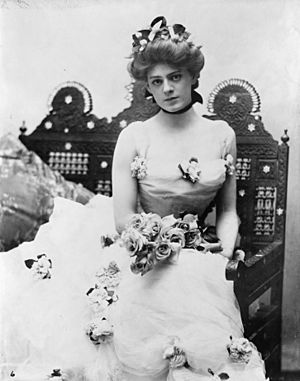
Barrymore had always professed a dislike of the acting profession, but in 1900 he was persuaded by his father to join him on stage for a few performances of a short play, "A Man of the World" which his father had produced in Fort Lee, New Jersey near his home in town. He appeared in the same piece again the following year, but he still thought of the experience as merely a way to supplement his income, rather than as a possible future career.
In May 1902, Barrymore was fired from his newspaper position after producing a poor illustration for the paper. He spent time as a poster designer but realized it was not lucrative enough for his lifestyle. While discussing his future with his brother, Barrymore said "it looks as though I'll have to succumb to the family curse, acting", and he later admitted that "there isn't any romance about how I went on stage. ... I needed the money."
Career
He began his career in 1903 and first gained attention as a stage actor in light comedy, then high drama, culminating in productions of Justice (1916), Richard III (1920) and Hamlet (1922); his portrayal of Hamlet led to him being called the "greatest living American tragedian".
After a success as Hamlet in London in 1925, Barrymore left the stage for 14 years and instead focused entirely on films. In the silent film era, he was well received in such pictures as Dr. Jekyll and Mr. Hyde (1920), Sherlock Holmes (1922) and The Sea Beast (1926). During this period, he gained his nickname, the Great Profile.
His stage-trained voice proved an asset when sound films were introduced, and three of his works, Grand Hotel (1932), Twentieth Century (1934) and Midnight (1939) have been inducted into the National Film Registry.
Personal life
Barrymore's personal life has been the subject of much attention before and since his death. He was married and divorced four times, and declared bankruptcy later in life. Much of his later work involved self-parody. Barrymore's biographer, Martin Norden, considers him to be "perhaps the most influential and idolized actor of his day".
Death
In October 1940, Barrymore returned to the NBC Radio network. On May 19, 1942, while recording a line from Romeo and Juliet for the show, Barrymore collapsed. He was taken to the Hollywood Presbyterian Hospital and died there on May 29, from cirrhosis of the liver and kidney failure, complicated by pneumonia. Barrymore was buried at Calvary Cemetery in Los Angeles on June 2. In 1980, Barrymore's son had his father's body re interred at Philadelphia's Mount Vernon Cemetery.
Legacy
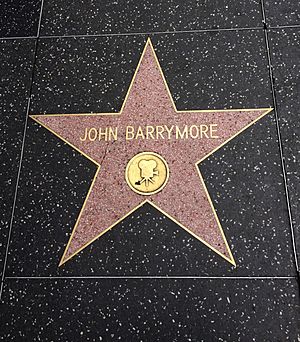
The New York Times obituary stated that the actor was accepted by most critics as the foremost English-speaking actor of his time. The Washington Post agreed, noting that during his stage triumphs and early years in film, he was the great profile, the darling of the 'royal family' of the stage."
Barrymore was honored on few occasions by the entertainment industry and its members. Although both his brother and sister won Academy Awards, the only award Barrymore ever received for his screen work was from Rudolph Valentino in 1925 for Beau Brummel. Valentino created an award in his own name and felt that his fellow actors should receive accolades for their screen work.
When Barrymore attended his ceremony at Grauman's Chinese Theatre in 1940, he left more than the customary hand and footprints in the theater's forecourt: aided by the owner, Sid Grauman, Barrymore left a cement imprint of his facial profile.
In February 1960, for his contribution to the motion picture industry, Barrymore was inducted into the Hollywood Walk of Fame with a star at 6667 Hollywood Boulevard; Barrymore, along with his two siblings, is included in the American Theater Hall of Fame.
The Barrymore "Royal Family" of actors continued through two of his children – his son with Costello, John Drew Barrymore and his daughter with Oelrichs, Diana – both of whom became actors, as did John Jr.'s daughter Drew.
Barrymore's achievements and his colorful life have ensured that several biographical studies followed his 1926 autobiography, Confessions of an Actor.
There were several celebratory events in 1982, on the centenary of Barrymore's birth. The Academy of Motion Picture Arts and Sciences and the Museum of Modern Art jointly hosted a commemorative program of his work. The same year, in celebration of the centenary of the Actors Fund of America, the US Postal Service issued a postage stamp featuring Barrymore and his siblings.
In February 2010, an intersection in Fort Lee, New Jersey, was renamed John Barrymore Way on what would have been the actor's 128th birthday. The intersection marked the spot of the former Buckheister's Hotel, where Barrymore had his 1900 stage debut in "A Man of the World".
Images for kids
-
Barrymore's drawing of himself and Ethel in A Slice of Life, 1912
-
Blanche Oelrichs, Barrymore's second wife (and mother of Diana Barrymore), who published poetry under the pseudonym Michael Strange
-
Dolores Costello in 1926; she was Barrymore's co-star in The Sea Beast and, later, his third wife.
-
Barrymore with Carole Lombard on a lobby card for Twentieth Century (1934)
-
(l to r), Fred MacMurray, Carole Lombard and Barrymore in True Confession, (1937)
-
Barrymore at the White House in January 1924, after meeting President Calvin Coolidge
-
Barrymore, drawn by John Singer Sargent, 1923
See also
 In Spanish: John Barrymore para niños
In Spanish: John Barrymore para niños




